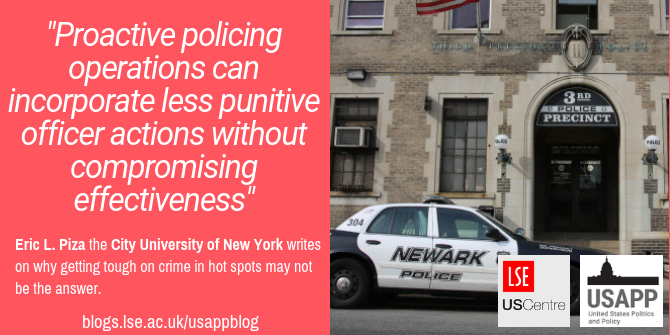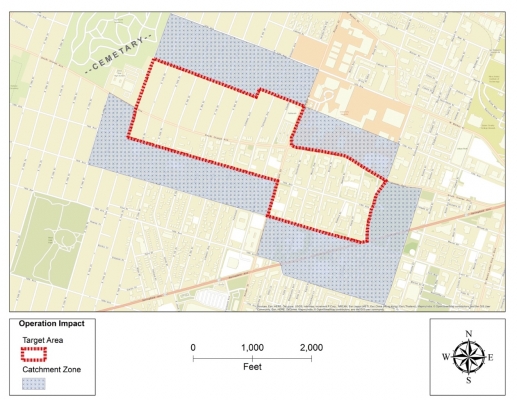 What is the best way for law enforcement to deal with crime ‘hot spots’? In recent years, police forces have tended to favor tougher enforcement strategies which proactively focus on the most problematic places. In new research which studies policing strategies in Newark, New Jersey, Eric L. Piza finds that what he calls ‘guardian actions’ such as citizen contacts, business, taxi and bus checks were much more effective at reducing the likelihood of violent crime compared to enforcement actions like arrests and interrogations.
What is the best way for law enforcement to deal with crime ‘hot spots’? In recent years, police forces have tended to favor tougher enforcement strategies which proactively focus on the most problematic places. In new research which studies policing strategies in Newark, New Jersey, Eric L. Piza finds that what he calls ‘guardian actions’ such as citizen contacts, business, taxi and bus checks were much more effective at reducing the likelihood of violent crime compared to enforcement actions like arrests and interrogations.
Research conducted during the “Professional Era” of policing (the early to mid-20th century) found that many traditional police activities, such as random patrol and rapid response to 911 calls, had little effect on crime. This led many to conclude that the police were ill equipped to make any meaningful impact on levels of crime. The sentiment towards police has since changed; now there is a great deal of scientific evidence which shows that contemporary police practices can indeed prevent crime. This has occurred due to a large-scale change in the police mission, with proactive strategies being emphasized much more than the reactive strategies that defined the Professional Era. A particular strategy that has amassed a robust record of success is Hot Spots Policing, which involves concentrating crime prevention resources within the most problematic micro-places (e.g. street corners and block faces) rather than evenly distributing resources throughout entire cities or neighborhoods. In 2004, the National Academy of Sciences’ Committee to Review Research on Police Policy and Practices found that interventions at crime hot spots provide the strongest collective evidence on police effectiveness that is now available. A systematic review and meta-analysis by Anthony Braga and colleagues provides further support for Hot Spots Policing.
Somewhat lost in these study findings is the fact that Hot Spots Policing can vary greatly in scope. On one hand, police activity in hot spots can take the form of law enforcement actions such as arrests, summonses, or field interrogations (what is commonly referred to as “stop, question, and frisk”). Conversely, police could affect crime by just being present and informal engagement with residents, relying less on punitive enforcement. Not enough is known regarding which of these types of activities most effectively prevents crime. This is an important gap in the knowledgebase in light of recent events that have caused tension between police and the communities they serve. Given that high levels of law enforcement actions can potentially increase such tensions, policing would benefit from more research on the types of officer actions that most effectively address crime.
To explore this topic, in new research I analyzed the activities of police officers who worked in the Newark, NJ Police Department’s (NPD) Operation Impact, a foot-patrol saturation intervention. On a nightly basis from the summer of 2008 through the summer of 2009, Operation Impact officers patrolled a quarter-square mile area suffering from the most disproportionate levels of violent crime in the city according to internal analyses of the NPD. Official enforcement actions were expected to take place on a frequent basis during the intervention. NPD commanders also recognized that, given their daily presence within the target area, foot patrol officers could (and should) conduct additional activities to combat crime.

“Newark Third Precinct Police Station” by Paul Sableman is licensed under CC BY 2.0
To capture all of an officers actions, the NPD created custom “after-action” reports that were completed by all Operation Impact officers during each tour of duty. The after-action reports captured daily counts of seven unique officer actions: arrests, field interrogations, quality of life summonses, citizen contacts, business checks, bus checks, and taxi inspections. These activities are different in nature, varying in their severity and reliance on traditional law enforcement. To reflect these differences, I considered arrests, field interrogations, and quality of life summonses as “Enforcement Actions” in the analysis. Citizen contacts, business checks, bus checks, and taxi inspections were jointly considered “Guardian Actions.”
Figure 1 – Operation Impact Target Area and Catchment Zone

My results show that guardian actions had a greater crime prevention effect than enforcement actions. Increased levels of guardian actions decreased the likelihood of violent crime by about 51 percent in the target area. This effect was heighted when limiting observations to the times that Operation Impact foot patrols took place (6pm to 2am). During this time period, a similar increase of guardian actions decreased the likelihood of violent crime by about 58 percent in the target area. Enforcement actions were not associated with a crime decrease in any of the analyses. Furthermore, my findings suggest that guardian actions did not simply reduce crime in the target area by causing offenders to commit crime elsewhere (a phenomenon often referred to as “displacement”). In all models, guardian actions of the Operation Impact officers were unrelated to crimes in the catchment zone surrounding the target area.
It’s important to note that the study design was not without limitations. For one, the data used in this study is now quite old (2009). This is largely due to data limitations, with the type of guardian actions included in this study not systematically captured in police databases. This required me to collect, code, and digitize hard copies of after-action reports submitted by foot patrol officers, with such reports only available for the Operation Impact intervention. I recommend that researchers replicate this study using updated data sources. While acknowledging these qualifications, I believe this study has important policy implications for contemporary policing. Since the Professional Era, American Policing has been defined by a warrior mindset whereby police view themselves primarily as “crime fighters” with enforcement actions considered the benchmark for measuring officer productivity. My current study adds to the small, but growing, body of research suggesting that proactive policing operations can incorporate less punitive officer actions without compromising effectiveness. Given the potential drawbacks of aggressive enforcement, and the fact that less intrusive actions can generate significant crime control benefits in certain contexts, police should consider more readily incorporating guardian actions into hot spots policing interventions.
- This article is based on the paper “The Effect of Various Police Enforcement Actions on Violent Crime: Evidence from a Saturation Foot Patrol Intervention” in Criminal Justice Policy Review.
- This paper was commissioned by the Misdemeanor Justice Project—Phase II funded by the Laura and John Arnold Foundation. Points of view or opinions contained within this document are those of the author and/or the participants and do not necessarily represent the official position or policies of the Laura and John Arnold Foundation and the Misdemeanor Justice Project.
Please read our comments policy before commenting.
Note: This article gives the views of the author, and not the position of USAPP – American Politics and Policy, nor the London School of Economics.
Shortened URL for this post: http://bit.ly/2N7oC6z
About the author
 Eric L. Piza – John Jay College of Criminal Justice, City University of New York
Eric L. Piza – John Jay College of Criminal Justice, City University of New York
Dr. Eric L. Piza is an Associate Professor at John Jay College of Criminal Justice, City University of New York. Eric’s previous professional positions include GIS Specialist of the Newark, NJ Police Department, Research Director for Crime Analytics of the Rutgers Center on Public Security, and Research Program Coordinator of the Police Institute. Dr. Piza is involved in a number of applied research projects focusing on the spatial analysis of crime patterns, problem-oriented policing, crime control technology, and the integration of academic research and police practice.




1 Comments